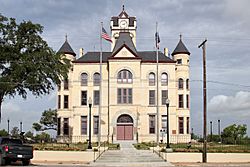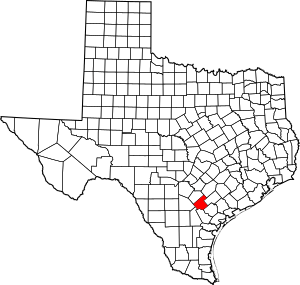Karnes County, Texas facts for kids
Quick facts for kids
Karnes County
|
|
|---|---|

The Karnes County Courthouse in Karnes City
|
|

Location within the U.S. state of Texas
|
|
 Texas's location within the U.S. |
|
| Country | |
| State | |
| Founded | February 4, 1854 |
| Named for | Henry Karnes |
| Seat | Karnes City |
| Largest city | Kenedy |
| Area | |
| • Total | 754 sq mi (1,950 km2) |
| • Land | 748 sq mi (1,940 km2) |
| • Water | 6.0 sq mi (16 km2) 0.8%% |
| Population
(2020)
|
|
| • Total | 14,710 |
| • Density | 19.509/sq mi (7.533/km2) |
| Time zone | UTC−6 (Central) |
| • Summer (DST) | UTC−5 (CDT) |
| Congressional district | 15th |
Karnes County is a special area in Texas, a state in the United States. It's called a county. In 2020, about 14,710 people lived here.
The main town, or "county seat," is Karnes City. The county got its name from Henry Karnes. He was a brave soldier during the Texas Revolution. Long ago, a train line called the San Antonio and Aransas Pass Railway went through Karnes County. It connected the cities of San Antonio and Corpus Christi.
Contents
Exploring Karnes County: Geography and Roads
Karnes County covers a total area of about 754 square miles (1,950 square kilometers). Most of this area, about 748 square miles, is land. The rest, about 6 square miles, is water.
Main Roads in Karnes County
These are the important highways that help people travel through Karnes County:
Neighboring Counties
Karnes County shares its borders with several other counties:
- Gonzales County (to the northeast)
- DeWitt County (to the east)
- Goliad County (to the southeast)
- Bee County (to the south)
- Live Oak County (to the southwest)
- Atascosa County (to the west)
- Wilson County (to the northwest)
Who Lives Here: Population Changes
The number of people living in Karnes County has changed over many years. Here’s a look at how the population has grown and shrunk:
| Historical population | |||
|---|---|---|---|
| Census | Pop. | %± | |
| 1860 | 2,171 | — | |
| 1870 | 1,705 | −21.5% | |
| 1880 | 3,270 | 91.8% | |
| 1890 | 3,637 | 11.2% | |
| 1900 | 8,681 | 138.7% | |
| 1910 | 14,942 | 72.1% | |
| 1920 | 19,049 | 27.5% | |
| 1930 | 23,316 | 22.4% | |
| 1940 | 19,248 | −17.4% | |
| 1950 | 17,139 | −11.0% | |
| 1960 | 14,995 | −12.5% | |
| 1970 | 13,462 | −10.2% | |
| 1980 | 13,593 | 1.0% | |
| 1990 | 12,455 | −8.4% | |
| 2000 | 15,446 | 24.0% | |
| 2010 | 14,824 | −4.0% | |
| 2020 | 14,710 | −0.8% | |
| U.S. Decennial Census 1850–2010 2010–2014 |
|||
People in 2020
In 2020, there were 14,710 people living in Karnes County. These people lived in 4,552 households, and 3,156 of these were families.
The population is made up of people from different backgrounds. About 36.63% were White (not Hispanic or Latino). About 7.59% were Black or African American. People of Hispanic or Latino background made up the largest group, at 52.58%.
Life in 2000
Back in 2000, there were 15,446 people. The county had about 21 people per square mile. Many households had children under 18 living with them. The average household had about 2.66 people.
The median age in the county was 34 years old. This means half the people were younger than 34, and half were older. For every 100 females, there were about 146 males.
The average income for a family was about $30,565 per year. Some families and people lived below the poverty line. This included about 29.10% of children under 18.
Economy: How People Make a Living
Around 2008, a company called ConocoPhillips found oil in Karnes County. This discovery led to a big economic boost for the area. It created new jobs and brought more money into the county.
Communities: Towns and Cities
Karnes County has several towns and cities where people live and work.
Cities
- Falls City
- Karnes City (This is the county seat, the main town for county government.)
- Kenedy
Town
Unincorporated Communities
These are smaller communities that are not officially cities or towns:
Ghost Towns
Some places that used to be communities are now "ghost towns," meaning most people have left them:
Education: Learning in Karnes County
Students in Karnes County attend schools run by different school districts:
- Falls City Independent School District
- Karnes City Independent School District
- Kenedy Independent School District
- Nixon-Smiley Consolidated Independent School District
- Nordheim Independent School District
- Pawnee Independent School District
- Pettus Independent School District
- Runge Independent School District
For higher education, Coastal Bend College is the community college for the county. It used to be called Bee County College.
See also
 In Spanish: Condado de Karnes para niños
In Spanish: Condado de Karnes para niños

